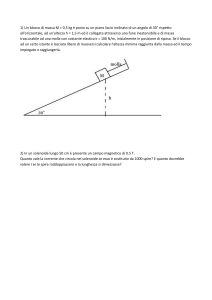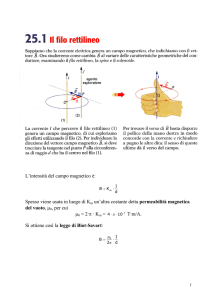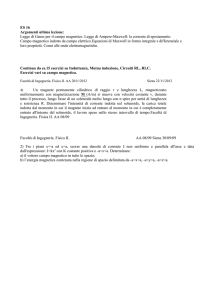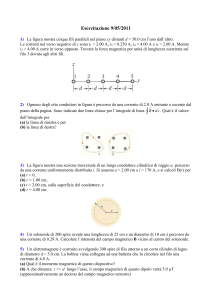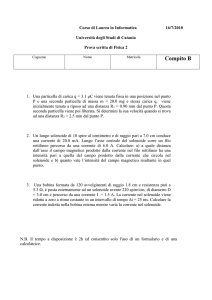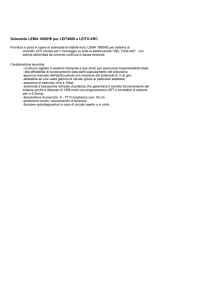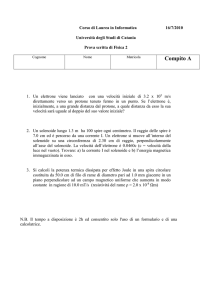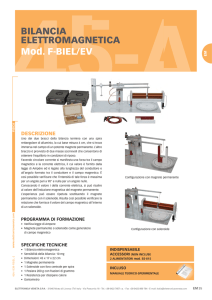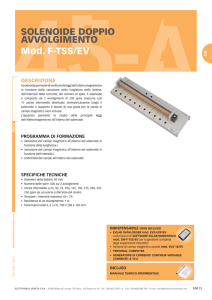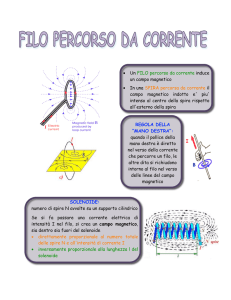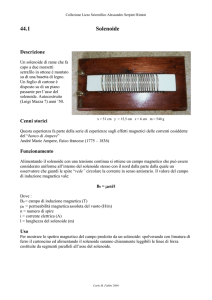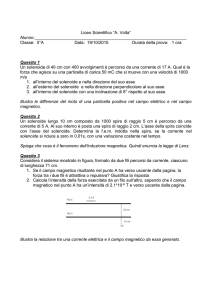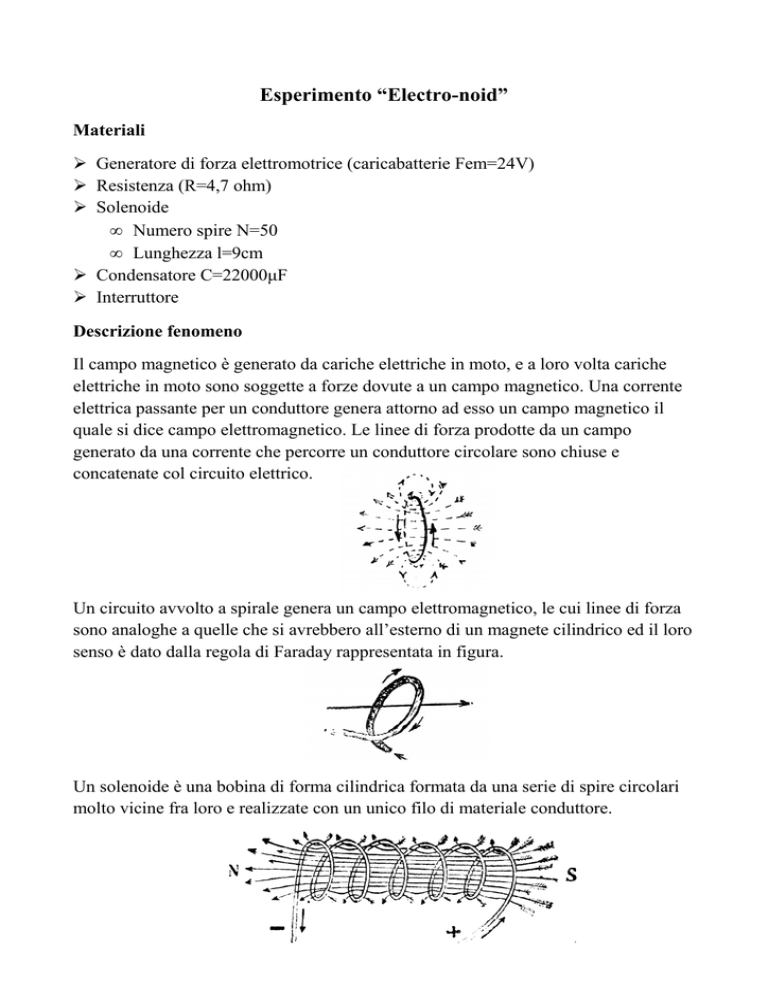
Esperimento “Electro-noid”
Materiali
Generatore di forza elettromotrice (caricabatterie Fem=24V)
Resistenza (R=4,7 ohm)
Solenoide
• Numero spire N=50
• Lunghezza l=9cm
Condensatore C=22000μF
Interruttore
Descrizione fenomeno
Il campo magnetico è generato da cariche elettriche in moto, e a loro volta cariche
elettriche in moto sono soggette a forze dovute a un campo magnetico. Una corrente
elettrica passante per un conduttore genera attorno ad esso un campo magnetico il
quale si dice campo elettromagnetico. Le linee di forza prodotte da un campo
generato da una corrente che percorre un conduttore circolare sono chiuse e
concatenate col circuito elettrico.
Un circuito avvolto a spirale genera un campo elettromagnetico, le cui linee di forza
sono analoghe a quelle che si avrebbero all’esterno di un magnete cilindrico ed il loro
senso è dato dalla regola di Faraday rappresentata in figura.
Un solenoide è una bobina di forma cilindrica formata da una serie di spire circolari
molto vicine fra loro e realizzate con un unico filo di materiale conduttore.
Facendo passare la corrente elettrica di intensità nel filo, si viene a creare un campo
magnetico dentro e fuori il solenoide direttamente proporzionale al numero totale
delle spire, all'intensità di corrente ed inversamente proporzionale alla lunghezza del
solenoide:
dove
mezzo,
è il numero totale delle spire, μ la permeabilità magnetica del
la lunghezza del solenoide e n il numero di spire per unità di lunghezza.
Se avviciniamo ad un solenoide un magnete permanente, disponendolo nella
direzione dell’asse, per effetto del campo magnetico generato nell’interno del
solenoide
ide abbiamo i seguenti fenomeni:
Se il polo del magnete affacciato al solenoide è di polarità uguale, viene
respinto.
Se il polo del magnete affacciato al solenoide è di polarità opposta viene
attratto nell’interno del solenoide.
Quando il magnete è disposto
disposto nell’interno del solenoide in modo che
coincidono le rispettive zone neutre, ogni azione cessa; ma se lo si allontana da
questa posizione, tirandolo un po’ fuori, non appena viene lasciato libero
ritorna nella posizione di prima.
Una sbarra di ferro dolce (nucleo) viene sempre succhiata perché si magnetizza
sempre nel senso del campo del solenoide, qualunque sia la direzione della
corrente.
La forza succhiante F varia con l’intensità del campo H e quindi con l’intensità
della corrente elettrica che circola nell’avvolgimento e con il numero delle spire
che formano il solenoide.
La velocità di spostamento del nucleo dipende dalla sua forma e dal suo peso e
dallo sforzo che deve vincere per essere succhiato.
Descrizione del circuito elettrico sperimentale
Il circuito elettrico progettato per l’esperimento è diviso in due parti: la prima
parte è un circuito RC (resistenza-condensatore) che carica il condensatore alla
stessa tensione della forza elettromotrice Fem pari a 24V (caricabatterie), la
seconda è un circuito LC (induttanza-condensatore) che, alla chiusura
dell’interruttore scarica tutta la corrente immagazzinata nel condensatore
attraverso il solenoide per generare il campo magnetico.
Modalità di esecuzione dell’esperimento
Dopo aver acceso il caricabatterie posizionare il magnete polarizzato come nella
figura sottostante alle estremità del solenoide e chiudere l’interruttore. A seconda
della polarizzazione del magnete, esso verrà espulso o attratto dal solenoide.
Electro-noid experiment
Materials
Electromotive force generator (battery charger): Fem=24V
Resistance: R=4,7 ohm
Solenoid
• Number of coils: N=50
• Length: l=9cm
Capacitor: C=22000μF
Switch
Description
The magnetic field is generated by electric charges in motion, as well as moving
electric charges are subject to forces due to a magnetic field. An electric current
passing through a conductor generates a magnetic field around it which is said
electromagnetic field. The lines of force produced by a field generated by a current
flowing through a circular conductor are closed and concatenated with the electrical
circuit.
A circuit wrapped spiral generates an electromagnetic field, whose lines of force are
similar to those that would occur outside of a cylindrical magnet and their sense is
given by the Faraday rule represented in the figure.
A solenoid is a coil of cylindrical shape composed by a series of circular coils very
close to each other and realized with a single wire of conductive material.
Making the electric current flowing in the wire with intensity , it creates a magnetic
field inside and outside the solenoid directly proportional
proportional to the total number of coils,
coils
the intensity of the current and inversely proportional to the length of the solenoid:
where
medium,
is the total number of coils,
coils μ the magnetic permeability of the
the length of the solenoid and n the number of coils per unit length .
If we put a permanent magnet close to a solenoid,
solenoid by placing it in the direction of the
axis, by effect of the magnetic field generated in the interior of the solenoid we have
the following phenomena:
• If the pole of the magnet facing the solenoid
solenoid is of the same polarity,
polarity it is rejected.
• If the pole of the
he magnet facing the solenoid is of opposite polarity,
polarity it is attracted
inside the solenoid.
• When the magnet is disposed within the solenoid in a way that meets their neutral
zones, all actions ceases,, but if you pull it away from this position,
position pulling it a little
bit out,, as soon as you release it, it returns to the original position.
position
A soft iron bar (nucleus) is always sucked because it is magnetized always in the
direction of the field of the solenoid, whatever is the direction of the current.
The suction force F varies with the intensity
intensity of the field H and with the intensity of
electrical current flowing in the winding and with the number of coils forming the
solenoid.
nucleus depends on its shape and his weight and the
The velocity of movement of the nucleus
effort that it must win to be sucked.
Description of the experimental electric circuit
The electric circuit is built in two parts: the first part is an RC circuit (resistorcapacitor) that charges the capacitor to the same voltage of the electromotive force
Fem equal to 24V (battery charger), the second part is an LC circuit (inductancecapacitor) that, after closing the switch all the current stored in the capacitor suddenly
flows through the solenoid to generate the magnetic field.
Procedures for the implementation of the experiment
After turning on the battery charger, position the magnet polarized as in the figure
below at the ends of the solenoid and close the switch. Depending on the polarization
of the magnet, it will be ejected or attracted by the solenoid.

